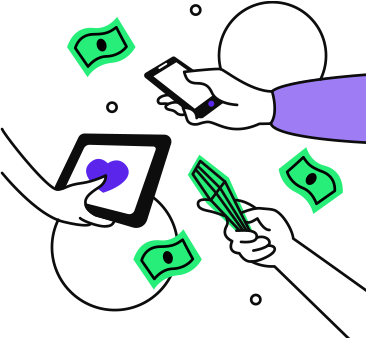You can only appreciate the benefits of the Apple ecosystem by replacing almost all your gadgets with Apple ones. Those who own an iPhone, a MacBook, an iPad, etc., unanimously comment on the seamless integration between their devices. However, as excellent as it is, Apple’s ecosystem has its weaknesses. Let’s find out what those are and if they are significant enough to prevent you from switching.
So, What Exactly is an Apple Ecosystem?
As you have probably guessed, building an ecosystem is not limited to linking three or more devices to an Apple ID. Instead, it refers to a synergetic environment created by Apple, which consists of hardware, software, and services working together.
The key components of the Apple ecosystem include:
- Gadgets. That’s your iMac, MacBook Pro, iPhone, HomePod, Apple TV, etc.
- Apple OS. The ecosystem is built for iOS (iPhone), macOS (Macbooks, Mac Pro, iMacs), and iPadOS (iPad) to work together as one across all devices.
- Software and apps. Apple developed a range of software and apps to enhance the functionality of all gadgets in the ecosystem: iCloud (cloud storage and synchronization), Apple Pay (mobile payment app), FaceTime and iMessage (video, audio calls, texts), iTunes (media player), Apple Music (streaming). It also includes third-party apps available in the App Store.
- Integration. This feature allows users to exchange texts and emails across all devices, take phone calls via Apple Watch or computer, etc.
- Security and privacy. Apple’s privacy policies and security measures aim to protect user data and maintain trust within its ecosystem. Take the recent CrowdStrike outage, for example: To date, Microsoft is still scrambling to address cybersecurity fallout globally while Apple remains unaffected.
- User experience. The Apple ecosystem’s emphasis on easy-to-use, intuitive interfaces and features caters to even less tech-savvy users.
In summary, the Apple Ecosystem successfully aims to provide a flawless experience across all gadgets, offering convenience, integration, and an array of features.
Advantages of the Apple Ecosystem
The components of the Apple ecosystem are well-known and loved by users. Skipping the benefits discussed above here is also why it stands out:
- Room for expansion: Apple products integrate with third-party software and hardware.
- Multimedia experience: iTunes, Apple Music, Apple TV+, and other services provide a comprehensive multimedia experience across all devices in the ecosystem.
- Customer support: Apple strives to be responsive and helpful, offering services through the network of Apple Stores, online, and over the phone.
- Easy to keep updated: Apple consistently provides software updates for older models, develops security patches, and extends their lifespan, allowing users to keep them in the ecosystem longer.
- Great build quality and design: Apple products are recognized for their premium build quality and sleek design, which enhances user experience and durability.
- Environmental factor: Apple emphasizes sustainability, using recycled materials, and reducing its carbon footprint in the manufacturing process.
- Resale Value: Although expensive, Apple electronics generally retain their value well compared to other brands, making them a good investment.
- Easy to upgrade: Apple has a trade-in program allowing users to get newer models and trade in older ones for an upgrade credit.
These advantages collectively contribute to the appeal of the Apple ecosystem, locking in many users for years to come.
Disadvantages of the Apple Ecosystem
Yes, the Apple ecosystem sounds pretty awesome so far, but it poses some drawbacks as well:
- Cost: Apple gadgets have premium price tags compared to competitors, which can be a barrier for budget-conscious consumers. At the same time, repairs also tend to be more expensive compared to non-Apple electronics, based on higher parts costs and the difficulty of disassembling them.
- Limited customization: Apple devices have less flexibility than Android or Windows products, particularly regarding software and hardware modifications.
- Dependency on iCloud: While iCloud provides convenient syncing, storage beyond the free tier incurs costs, and users may feel pressured to stay within Apple’s ecosystem for seamless integration.
- Limited hardware choices: Apple offers a smaller range of device models than its competitors, particularly in niche categories like gaming laptops or budget smartphones.
- Compatibility issues: While Apple devices are generally compatible with each other, problems can occur when using Apple electronics with non-Apple hardware or software.
- Closed ecosystem: Apple’s ecosystem is tightly controlled, which can limit choices for users who prefer more open platforms or who want to use non-Apple services.
- Lock-In effect: Once you invest in Apple, opening up your ecosystem or switching to another one can be cumbersome due to compatibility issues and reliance on Apple-specific services.
Apple Ecosystem vs. Android
When choosing between the two, factor in the following:
1—Your budget. Android gadgets are generally less expensive, and your future upgrades will be cheaper.
2—Preferences. Some people value customization, while others appreciate ease of use and seamless integration. Choose the platform based on how you use your gadgets.
3—The lock-in effect. Again, you must factor it in when debating between Apple and Android. It is easy to fall for the integration “trap” and end up with a rigid all-Apple system. Unless you are an avid Apple fan and plan on being loyal in the future, consider the flexibility of using different brands together and the ability to work across various platforms before committing.
4—Privacy and security. Apple is known for beefed-up privacy and security features, but Android offers more flexibility and openness.
So, let’s now talk about the apparent advantages of the Android ecosystem over Apple:
For one, Android has more variety. Its ecosystem does not limit users to just one brand, offering freedom to choose a gadget that meets their specific needs and budgets. Secondly, as we already mentioned, there is more room for customization (of both hardware and software). Android products are more affordable and come in a range of price points. They seamlessly integrate with Google services, such as Gmail, Google Drive, and Google Photos. And lastly, Android is an open-source platform, making its ecosystem less rigid. Here, developers can create apps and customize the operating system, which fosters innovation and diversity in applications and expands their features.
Apple Ecosystem: Reseller Perspective

To make the most of your ecosystem, you will need to upgrade your Apple products periodically (and probably more often than you would expect). So, how can one make that switch more cost-effective?
Apple largely addressed the issue by offering users generous trade-in credits to keep them as customers, making upgrades with trade-in via Apple Store a no-brainer. However, you won’t be able to take advantage of this program if your device is less than perfect and has functional defects.
Luckily, Apple electronics hold residual value over time, even if they are not fully working. As a result, it may make sense to continue paying the premium if you know you can sell your Apple gadgets and keep the ecosystem up to date by reinvesting that cash into newer models. Furthermore, you can save even more if you buy pre-owned or refurbished Apple electronics instead of brand-new ones.
In conclusion
As we can see, the Apple Ecosystem is designed to create a seamless user experience across devices. Its robust features and services can enhance productivity, communication, and entertainment, making our lives easier. However, it also assumes a long-term commitment: Leaving the ecosystem can be difficult once locked in. Therefore, you should factor in the cost of upgrades and your reliance on Microsoft and Android-based software in your work process before going all-Apple.










